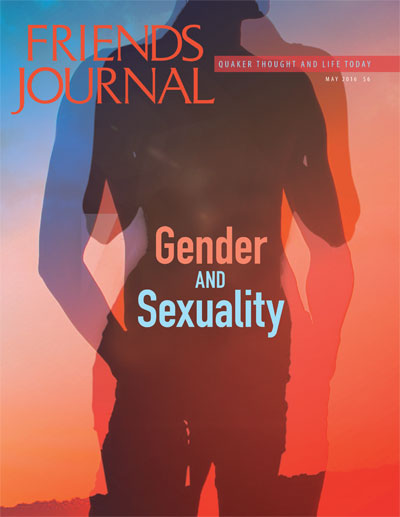How Way Opened at George School to Support Transgender Students

FJ PODCAST SUBSCRIPTION: ITUNES | DOWNLOAD | RSS | STITCHER
Ivy officially changed her name to Ivy only a few months ago. But even at a young age, she remembers wishing she were a girl—once waking up her mother in the middle of the night to tell her so. At four years old, she had no way of knowing that one day she would again tell her mother she was a girl—this time definitively—or that her gender identity would help set the wheels in motion for a new policy at George School to support transgender students.
There are approximately 700,000 transgender individuals in the United States, according to a 2011 study by the Williams Institute, a think tank at UCLA Law that researches sexual orientation and gender identity law and public policy. Ivy is not the first transgender individual to attend George School—nor will she be the last—but she is the first student to benefit from the recently approved policy to support transgender students, and she is the first to choose a dorm based on her gender identity, not her assigned sex at birth.
Shortly after Ivy had approached her mother, George School began to put together a task force to consider how the school might best support transgender students and enable them to safely and comfortably live their lives.
This wasn’t the first time George School had discussed transgender issues. The Student Life Committee had been talking about transgender issues for a while, but it wasn’t until Ivy came forward that the conversations felt real.
At that point the Student Life Committee established an ad hoc transgender task force, clerked by Jody Rogers ‘79, George School board member and a surgeon in the Midwest. “We weren’t speaking theoretically anymore. We knew we would be helping actual George School students, the sooner the better,” said Julia Nickles ’03, a member of the transgender task force and George School faculty member.
When the work of the task force began, it quickly became clear that it wasn’t a question of whether or not a policy would be created but rather a question of what the policy needed to say. The task force spent months researching policies at other boarding schools (turns out there weren’t any), learning about issues of gender identity, discussing the differences between gender identity and sexuality, and drafting the policy to get it just right.
Draft in hand, members of the task force brought the policy to the Board of Trustees in April 2015. The presentation began with a slideshow created by Jody Rodgers. The first few slides of the presentation read as follows:
Imagine you have a condition with a lifetime mortality rate of 41 percent. Now imagine you have a drug that will reduce that mortality to nearly 0 percent. Would you take that drug? What if it were your child?
The suicide rate among transgender individuals is at 41 percent. When those individuals are living within an accepting community, the suicide rate drops below 1 percent.
For the board, this was an easier decision than anyone anticipated. It was difficult to argue with the statistics, and the fact that this was not a theoretical discussion but rather involved a real student helped to ground the discussion. In the end, members’ commitment to the Quaker testimony of community and a shared desire to provide an accepting community experience for all of our students opened the way to unity. The policy was approved.
“It was a Saturday around 10:00 a.m. when Julia called me,” said Ivy. “They were expecting it would take until the next board meeting to approve, so when she called, I didn’t believe her at first. I thanked her profusely and then I went into the shower and just danced. I had a roommate who didn’t yet know, so the shower was the only place I could celebrate.”
From there, things unfolded quickly. The newly approved policy was presented to faculty and students, and again received overwhelming support. Ivy learned that she would be able to live in a girls’ dorm, a step that acknowledged and affirmed that George School heard her and recognized who she was. “Everything just opened up,” said Ivy.
Over the summer, Ivy began wearing different clothes and presenting as a girl. Her friends, unequivocally supportive, helped explain her transition when Ivy struggled to find the words. A former roommate sent a text to a third of the junior class celebrating Ivy’s decision and encouraging her classmates to be supportive. In a way, her transition at George School was easy.
“It’s George School; I wouldn’t expect anything different,” said Ivy.
Now the members of the task force are actively supporting other Friends schools as they create policies of their own, and they are working to normalize transgender issues at George School, including asking individuals about their preferred pronouns. The school is also working on converting single stall bathrooms on campus to be gender-neutral and considering other ways to make campus friendlier to transgender students.
Thanks in part to a supportive school community, the future for Ivy looks bright. She is enjoying life as a girl and working on building her college list. She plans to perhaps pursue a career in software engineering after earning a degree in physics, but first, she has another year at George School to complete.



Bravo, George School!
Wonderful story. Thank you for showing how to be inclusive.
I would love to know where I can find the “less than 1 percent” statistic, as I would like to use it myself and want to be ab le to point a primary source. If someone has it, would you please post or email the information to al99terego@gmail.com. Thank you!